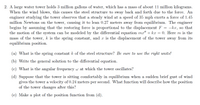
Advanced Engineering Mathematics
10th Edition
ISBN: 9780470458365
Author: Erwin Kreyszig
Publisher: Wiley, John & Sons, Incorporated
expand_more
expand_more
format_list_bulleted
Concept explainers
Topic Video
Question
Ordinary Partial diff. eqn.
Solve question 2. a, b, c,d and e.

Transcribed Image Text:2. A large water tower holds 3 million gallons of water, which has a mass of about 11 million kilograms.
When the wind blows, this causes the steel structure to sway back and forth due to the force. An
engineer studying the tower observes that a steady wind at a speed of 35 mph exerts a force of 1.45
million Newtons on the tower, causing it to lean 0.27 meters away from equilibrium. The engineer
begins by assuming that the restoring force is proportional to the displacement F = -kx, so that
the motion of the system can be modeled by the differential equation mx" + kx = 0. Here m is the
mass of the tower, k is the spring constant, and x is the displacement of the tower away from its
equilibrium position.
(a) What is the spring constant k of the steel structure? Be sure to use the right units!
(b) Write the general solution to the differential equation.
(c) What is the angular frequency w at which the tower oscillates?
(d) Suppose that the tower is sitting comfortably in equilibrium when a sudden brief gust of wind
gives the tower a velocity of 0.24 meters per second. What function will describe how the position
of the tower changes after this?
(e) Make a plot of the position function from (d).
Expert Solution
This question has been solved!
Explore an expertly crafted, step-by-step solution for a thorough understanding of key concepts.
This is a popular solution
Trending nowThis is a popular solution!
Step by stepSolved in 4 steps with 3 images

Knowledge Booster
Learn more about
Need a deep-dive on the concept behind this application? Look no further. Learn more about this topic, advanced-math and related others by exploring similar questions and additional content below.Similar questions
- The salesclerk at TV-Rama says that the area of a 52 in. plasma screen is four times as large as the area of a 26 in. screen. Television screens are measured on the diagonal. Is the salesclerk correct? Explain.arrow_forwardHelparrow_forwardSolve linear eqaution by addition mehtod. X+y=5 X-y==11arrow_forward
- (45 where & 2 a. a. The length of one side of a square tile is 1 feet. Determine the area of the tile in square feet (use A = s²). #H How many tiles would you need to cover a 9-foot by 10-foot bathroom floor, assuming no errors or waste?arrow_forwardSolve for m. The solution is m = | (Use integers or fractions for any numbers in the expression. Simplify your answer.) p= 3m + 3v Question Viewer Enter your answer in the answer box rch #メ A prt sc delete home %23 3. %24 4 & 7. backspace D F J. K pause alt ctrlarrow_forwarddo all 6 questions please. questions 5, 6, 7, 8, 9, and 10.arrow_forward
arrow_back_ios
arrow_forward_ios
Recommended textbooks for you
 Advanced Engineering MathematicsAdvanced MathISBN:9780470458365Author:Erwin KreyszigPublisher:Wiley, John & Sons, Incorporated
Advanced Engineering MathematicsAdvanced MathISBN:9780470458365Author:Erwin KreyszigPublisher:Wiley, John & Sons, Incorporated Numerical Methods for EngineersAdvanced MathISBN:9780073397924Author:Steven C. Chapra Dr., Raymond P. CanalePublisher:McGraw-Hill Education
Numerical Methods for EngineersAdvanced MathISBN:9780073397924Author:Steven C. Chapra Dr., Raymond P. CanalePublisher:McGraw-Hill Education Introductory Mathematics for Engineering Applicat...Advanced MathISBN:9781118141809Author:Nathan KlingbeilPublisher:WILEY
Introductory Mathematics for Engineering Applicat...Advanced MathISBN:9781118141809Author:Nathan KlingbeilPublisher:WILEY Mathematics For Machine TechnologyAdvanced MathISBN:9781337798310Author:Peterson, John.Publisher:Cengage Learning,
Mathematics For Machine TechnologyAdvanced MathISBN:9781337798310Author:Peterson, John.Publisher:Cengage Learning,


Advanced Engineering Mathematics
Advanced Math
ISBN:9780470458365
Author:Erwin Kreyszig
Publisher:Wiley, John & Sons, Incorporated

Numerical Methods for Engineers
Advanced Math
ISBN:9780073397924
Author:Steven C. Chapra Dr., Raymond P. Canale
Publisher:McGraw-Hill Education

Introductory Mathematics for Engineering Applicat...
Advanced Math
ISBN:9781118141809
Author:Nathan Klingbeil
Publisher:WILEY

Mathematics For Machine Technology
Advanced Math
ISBN:9781337798310
Author:Peterson, John.
Publisher:Cengage Learning,

